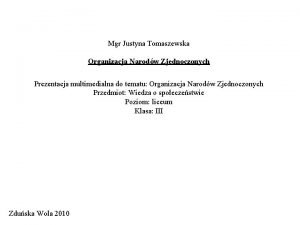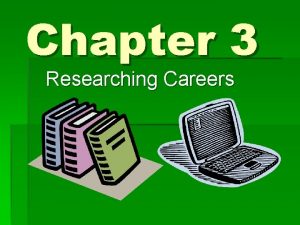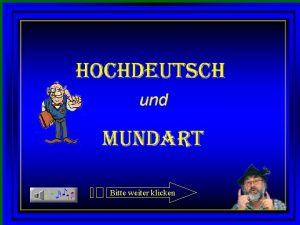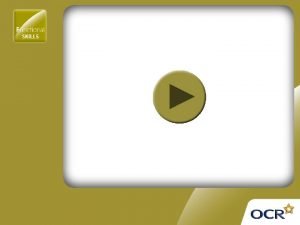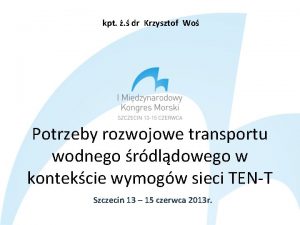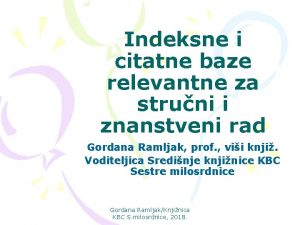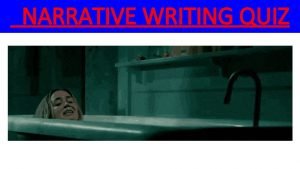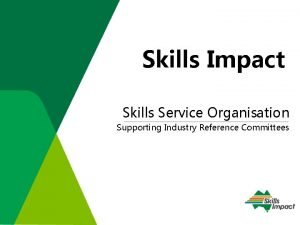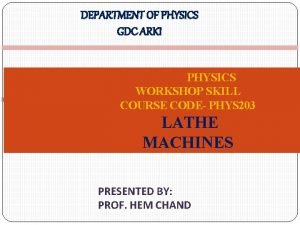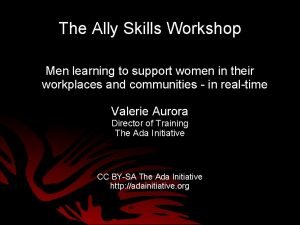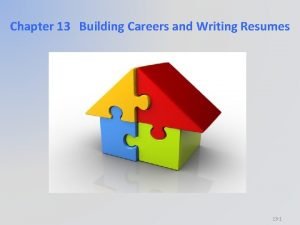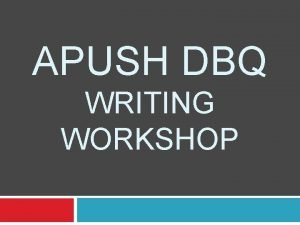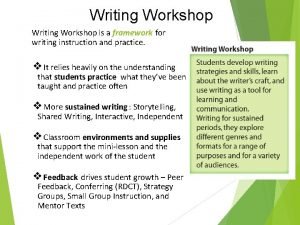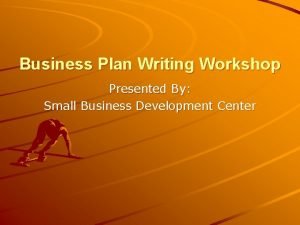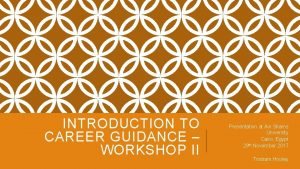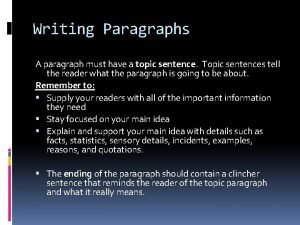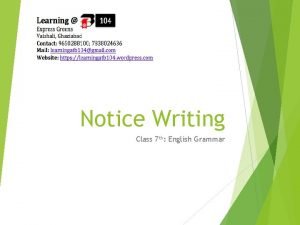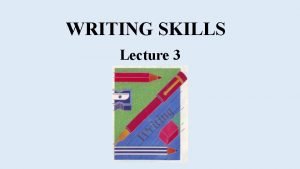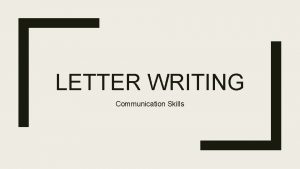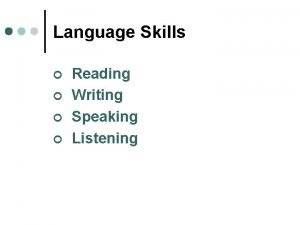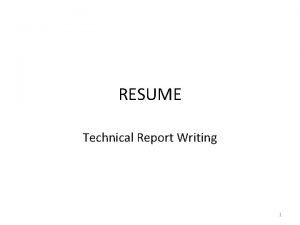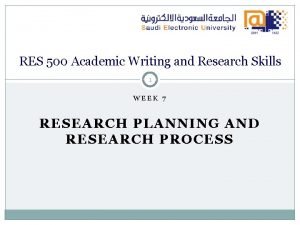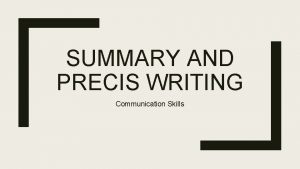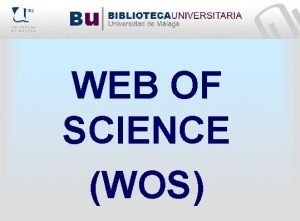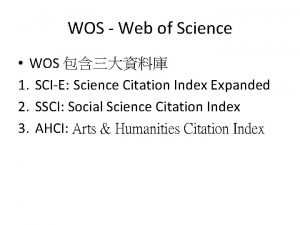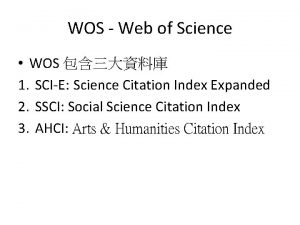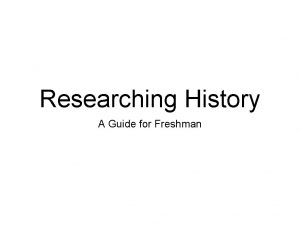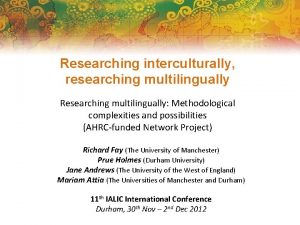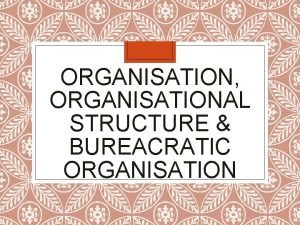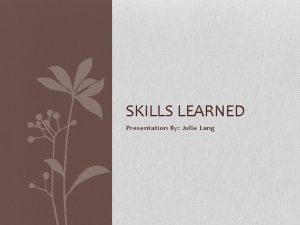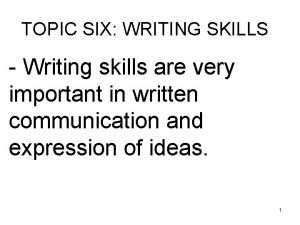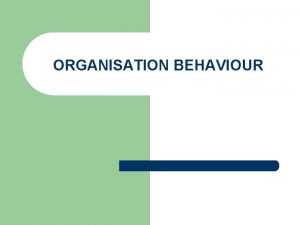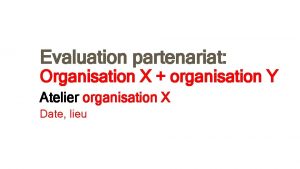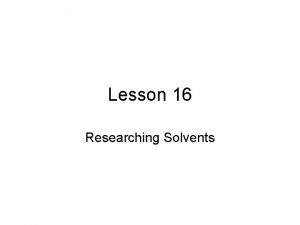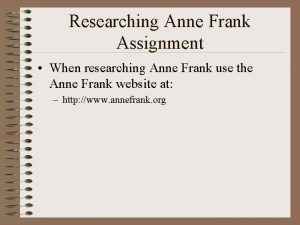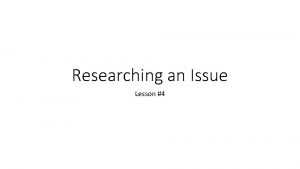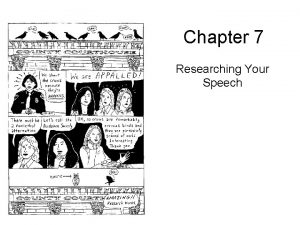Writing Organisation Skills WOS Workshop RESEARCHING A TOPIC







































- Slides: 39

Writing Organisation Skills (WOS) Workshop RESEARCHING A TOPIC, PLANNING, WRITING AND EDITING AN ESSAY

Week One: Researching Skills Learn how to distinguish between the three main types of writing tasks: persuasive, expository, and informative. Learn and practice a strategy for helping them choose the best topic for an openended essay (an IB skill). Learn and practice a strategy for efficiently and effectively reading and understanding large amounts of informational text (i. e. an encyclopaedia entry). Technology tips: Students will learn how to use the built-in (free) Mac. Book and Word apps to help with reading, writing and editing.

Three main types of writing tasks Narrative What are some similarities? (Style, format, etc. ) What are the main differences? Expository Persuasive

Choosing the best topic The best topic is the one that you could support, which may not be the one you like or want to do. Rational v. Emotional decision making What do I know about the topic? How do I feel about the topic?

STOP Reading S: Scanning (context clues- titles, sub titles, pictures, bold words, etc. ) T: Titles into questions (Using Costas question stems) O: Omit unnecessary information P: Paraphrase, summarise (using a summary strategy) Reading Sample for STOP

Technology tips- typing Especially useful for citing quotes and for spelling unknown words.

Technology Tips- Reader Especially useful for reading and proofreading.

Summary Three types of essays, each require a different type of thinking and organization. The topic doesn't matter; it doesn't matter if you like it; write about what you can support the easiest. Done is better than perfect. STOP Reading for information is different than reading for pleasure. Use technology whenever possible; especially for spelling and proofreading.

Week Two: Planning Skills for Writing How to build a winning thesis statement Techniques for planning; including: Structured (e. g. Outlining/Point Explain Example/What-Why-How) Unstructured (e. g. mind mapping, visualisation) Learn which types of plans are most effective for different writing tasks. Techniques to gather and organize information, such as quotes and citations, that specifically support their thesis statement. Time management strategies for planning and writing during a timed writing assessment.

Thesis statement The most important sentence in your essay, but rarely the first thing you’ll write. It is written after the research (and often after the planning) It takes a position Answers the question or addresses the topic in a way that is specific. The tests: So what? Why? How?

Thesis examples Not useful Potentially useful Useful The North and South fought the Civil War for many reasons, some of which were the same and some different. While both sides fought the Civil War over the issue of slavery, the North fought for moral reasons while the South fought to preserve its own institutions. While both Northerners and Southerners believed they fought against tyranny and oppression, Northerners focused on the oppression of slaves while Southerners defended their own right to selfgovernment. Mark Twain’s Huckleberry Finn is a great American novel. In Huckleberry Finn, Mark Twain develops a contrast between life on the river and life on the shore. Through its contrasting river and shore scenes, Twain’s Huckleberry Finn suggests that to find the true expression of American democratic ideals, one must leave “civilized” society and go back to nature.

Structured Planning PEE: Point, Explain, Example WWH: SEXI: What, Why, How Sentence, Explain, e. Xamples, Importance

P. E. E. Point Explain Example/Evidence State your point in one sentence. Explain your point more clearly. Give some evidence or provide an example (or both!) to support your explanation.

W. W. H. What Why How State what you want to say in one sentence. State why it is important for the reader to know that. State How you know it is true. This is an example or evidence

SEXI Sentence Explain / e. Xamples Importance A Topic sentence to tell the reader what the paragraph is going to be about E for Explanation. An explanation of the point you’re making in this paragraph. I for Important. An outstanding essay will try to explain why this point is important to the essay as a whole. X for e. Xamples or justifications. You need to back up the point you made in the Explanation.


Unstructured planning Mind Mapping Main idea in the middle 3 -4 arms of support Evidence and examples form each arm Its ok to use images instead of words Mind. Node App


Gather and organize information One sheet of citations, quotes and page numbers. Copy/paste onto one document Annotations and highlighters: Three-color coding by P/E/E for each point Use technology: never create a bibliography by hand. Citation manager in Word, Pages, or apps like Zotero. org

Time spent planning Outside of class essay Reading, researching and planning should make up about 60% of your time that you spend on the total essay. For example, 5 hours should be: 2 hours researching and gathering quotes 1 hour planning 1 hour drafting (actual time writing) 1 hour revising In-class essay Your research and reading should be done outside of class as much as possible. Draw boxes for your plan (WWH) Plan at least 15 minutes of each hour You can under plan, but you cannot over plan.

Week Three: Writing Skills Learn how to write with the reader’s perspective in mind. Learn how to ‘show, not tell’ the reader their main idea, using tools such as prepositional phrases or using vivid verbs - A 'Body-Building' session. Understand how to sequence events using transition words. Support a point effectively, using details, quotes, examples and personal anecdotes.

Keeping the reader in mind Who is going to read your paper? Should you use I, You, He/She/It/They? It should be consistent. Different audiences, in different situations, need different language. Generally, keeping it simple and specific is often more useful than using bigger or more complex words. Show, don’t tell: Using VIVID VERBS Source: Boundless. “Keeping the Audience in Mind. ” Boundless Business Boundless, 20 Sep. 2016. Retrieved 31 Jan. 2017 from https: //www. boundless. com/business/textbooks/boundless-business-textbook/business-writing-5/word-choice-46/keeping-the-audience-inmind-234 -3213/

Killing the BE verb ‘To Be’ is the most used (and overused) verb in writing. Only one “To Be” verb is allowed per paragraph

24







Practice To BE Janet is the supervisor of the customer service department. Walt Disney was the initiator of a mass movement in family entertainment. In the distance there is a giant eruption from the water, as a 100 -pound sailfish jumps out. Not To BE 1. 2. 3. http: //www. grammar-worksheets. com/worksheets/pdfs/Lesson. Strong. Verbs. Exercises. Only. pdf

Telling or Showing: Can the camera see it? Telling Daniel walked there. William was late to the meeting. Valek was angry. I stopped drinking water. Showing Daniel strutted/sauntered/stumbled/ skipped there. William dashed into the meeting after we began. "Valek hurled a rock toward me. Stunned, I froze as the stone whizzed past and exploded on the wall behind me. " My goblet stopped short of my lips.

Transition words A word, phrase, or sentence that connects your ideas. (Download here) They function as signs for readers that tell them how to think, organize and react to old and new ideas as they read through what you have written Above all Finally Meanwhile Afterward First and foremost Next All things considered For this reason No doubt Accordingly From here on Of course Another For instance / For example On the other hand http: //education. wichita. edu/caduceus/examples/essay_student/transitions. htm

Introduction Body paragraph #1 Body paragraph #2 Conclusion

NTSBWTSW! NO TWO SENTENCES BEGIN WITH THE SAME WORD

Week Four: Editing and Revision skills Learn how to use the assignment rubric to edit with the Content, Purpose and Audience in mind (the CPA method). How to be an effective peer editor. Use technology tools to check for unintentional plagiarism and missed citations.

CPA method Content Purpose Audience

Peer editing like a pro Use the teacher’s rubric When you edit for them, you are actually learning how to edit your own paper. Its nice to be honest

Technology tools Grammarly Turnitin APPS: i. Write A simple way to jot down notes and text Writed Distraction free writing and editing Word. Air Simple tool for writing with a live word count
 Organizacje międzynarodowe tomaszewska
Organizacje międzynarodowe tomaszewska Avaya wos
Avaya wos Chapter 3 researching careers
Chapter 3 researching careers Researching wan technologies
Researching wan technologies Bitte nicht klicken
Bitte nicht klicken Researching
Researching Wos
Wos Wos kategori normalize atıf etkisi (cnci)
Wos kategori normalize atıf etkisi (cnci) Dr krzysztof woś
Dr krzysztof woś Researching the corruption
Researching the corruption Wos baza
Wos baza Narrative writing quiz
Narrative writing quiz Skills service organisation
Skills service organisation Examples of clinchers
Examples of clinchers What are the steps in narrowing down research topic
What are the steps in narrowing down research topic Tool holding devices in lathe
Tool holding devices in lathe Sax
Sax Chapter 13 writing workshop resumes
Chapter 13 writing workshop resumes Document based questions
Document based questions Writing workshop framework
Writing workshop framework Business plan writing workshop
Business plan writing workshop Presentation
Presentation Career guidance presentation
Career guidance presentation Proposal writing on career guidance workshop
Proposal writing on career guidance workshop ü
ü Hard skill
Hard skill Skills passport
Skills passport Stepuptowriting
Stepuptowriting 11 sentence paragraph structure
11 sentence paragraph structure Informational writing topic sentence starters
Informational writing topic sentence starters Notice writing format
Notice writing format What is essay writing
What is essay writing Principles of teaching writing
Principles of teaching writing Functional writing examples
Functional writing examples Letter writing communication skills
Letter writing communication skills Objectives of speaking skills
Objectives of speaking skills Conclusion for writing skills
Conclusion for writing skills Report writing resume
Report writing resume Academic writing and research skills
Academic writing and research skills Summary writing on communication
Summary writing on communication
